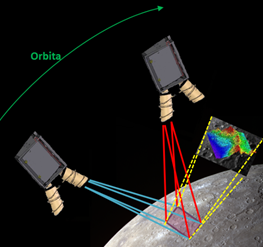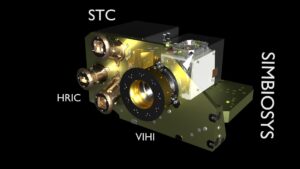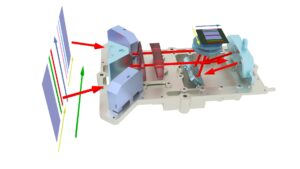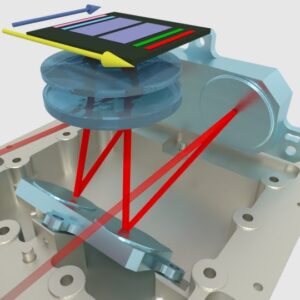
BepiColombo is one of the European Space Agency ‘cornerstone’ missions. BepiColombo is dedicated to study the Mercury planet, i.e. the innermost planet of our solar system. The BepiColombo spacecraft launch took place on 20 Octobert 2018 at 3:45 (CEST) (video del lancio).
The core of the mission is SIMBIO-SYS (Spectrometers and Imagers for MPO BepiColombo Integrated Observatory SYStem), an instrument that represents the state of the art in miniaturization of components and flying mechanics, made 80% by the Italian scientific community.
With a weight of just 13.8 kg, SIMBIO-SYS consists of a suite of three cameras that will have the task of covering numerous scientific objectives: a high resolution camera for the detailed study of the geology of Mercury, a stereocamera for 3D reconstruction of the entire surface is a hyperspectral chamber dedicated to the study of the composition of the surface.
For the first time Italy has the responsibility of almost all the instruments of remote sensing (three out of four) on board a planetary mission.
The Principal Investigator of SIMBIO-SYS is Gabriele Cremonese (INAF-OAPd), while Fabrizio Capaccioni (INAF-IAPS) is the head of the hyperspectral chamber VIHI (Visible and Infrared Hyperspectral Imager), Pasquale Palumbo (Parthenope University of Naples) is responsible the high resolution camera HRIC (High Resolution Imaging Channel) and Maria Teresa Capria (INAF-IAPS) is responsible for the STC (STereo Camera) stereo camera.

The CNR-IFN Padova, responsible for the development of the optical part and the calibration of the STC, plays an important role on STC. “The stereocamera is an instrument formed by two channels – in practice two eyes – that by observing an object from two different angles allows us to reconstruct the ‘third dimension’,” explains researcher Vania Da Deppo. “The STC instrument, created by the company Leonardo S.pA. of Florence, will allow us to determine the height of the mountains and the depth of the craters of Mercury”.
The technical supervision of SIMBIO-SYS is by Stefano Debei (Cisas-University of Padua), and among the other departments of the University of Padua involved there are also the Department of Geosciences and the Department of Information Engineering. Part of the operations, in particular with regard to electronic components, also involve France with the Laboratoire d’Etudes Spatiales et d’Instrumentation en Astrophysique (LESIA) of the Observatoire de Paris and the Institut d’Astrophysique Spatiale (IAS) of the CNRS.
SIMBIO-SYS was delivered to the European Space Agency on 20 April 2015: the handover took place at the end of the calibration activities carried out between February and March at the Institut d’Astrophysique Spatiale of the CNRS in Orsay and in the previous months at the Leonardo SpA laboratories. Now the integrated instrument on board the probe traveling to Mercury. For updates on the journey of BepiColombo visit the sito ufficiale ESA.
STC CNR-IFN Team: Vania Da Deppo, Paola Zuppella, Chiara Casini, Paolo Chioetto, Antonela Comisso, Giampiero Naletto (Dept. of Physics and Astronomy)
[Former team members: Emanuele Simioni (now at INAF-OAPd), Alessandra Slemer (now @ Adaptica)]
STC Image gallery





